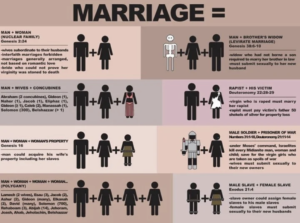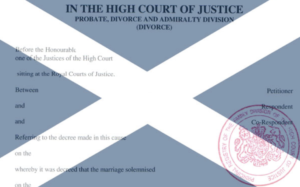

Historically, marriage was a property exchange (that is, chattels were needed), or a way of ensuring stability for the woman, or a way for a man to continue their lineage. It has changed a lot since then. Some would find at least 8 different forms of marriage in the Bible, not just the one we are accustomed to.
In this week’s Gospel reading (Mark 10:2-16) Jesus and his entourage are working their way to Jerusalem. The Pharisees were seemingly out to test Jesus. If the author is seeking to portray this back in Jesus’ day, the Pharisees were the ones who would encourage people to follow the Law; they were part of the Jewish religious party. Post the destruction of the Temple (66-70AD) in Jerusalem, when it is believed that this Gospel was written, the Pharisees became those who “keenly” encouraged the Rabbinic form of Judaism. The topic of divorce is quickly raised. Get this question wrong and Jesus might well be on his way to death. (Irony)
Divorce – the meaning

Time to put away what we currently perceive divorce might mean. The author in Mark 10:4 uses αποστατιον, which means ‘to leave one’s station’, possibly even defect, when relating to the divorce certificate, but then uses απολυω, when speaking on the second occasion about divorce: this word means freeing. Interesting comparison: permission to defect, and to be free.
There is a discussion relating to the Hebrew Scriptures, where they trade an understanding of a relationship between a man and a woman (Gen 2:24), and Deut 24:1 (“If a man marries a woman who becomes displeasing to him because he finds something indecent about her, and he writes her a certificate of divorce, gives it to her and sends her from his house“) which gives the man reason for a divorce. Not much in reality – notice that there’s little a woman can do.

Jesus compares these two verses, and speaks of the real focus of a healthy partnered relationship which should be at the heart of the matter, but they are hard-hearted. He returns back to Genesis 2:4. We might tend to think, as I did, that this might leave the women socially and economically destitute. Amy-Jill Levine doesn’t agree. Jewish woman had a marriage contract, known as a ketubah. This would give them sufficient protection from financial ruin in the case of divorce. Levine discusses in great detail the status of women in Jewish culture then, that Jesus’ stance here isn’t about equality with respect to divorce for women here, but a radical move away from the legality to a focus upon the relationship, the heart of a marriage.
It is Myers who writes: “Patriarchal practice drives a wedge into the unity and equality, originally articulated in the marriage covenant”
Myers, Binding the Strong Man
If Jesus were to directly empowering women, would we not see more of the disciples as women, women attending the transfiguration, or in leadership roles? None are recorded, albeit I might argue that Luke 8:1-3 offers a list of women in a privileged leadership role. Perhaps it wasn’t empowering but seeking a return to the radical reformation of what was originally planned (Gen 2:4) – a healthy relationship? What do you think?
So, if we were to assume that marriage was a property exchange or a way to maintain patriarchal control, we have missed this important lesson from Jesus. This is not arguing that women should be kept in abusive relationships – as tacitly reported during the US elections recently; but that Jesus is imploring us to free women from such an abusive system, so that we focus upon that loving relationship. It can be considered today, beyond the stereotypical male/female relationship, but that all who seek such a healthy loving relationship, regardless of their gender, are welcomed by God. Note that in the New Testament, other than Mary and Joseph, Anna and Simeon (to a degree), Jairus and his wife, none of the other women who encounter Jesus are depicted with an accompanying husband. Please correct me if I am wrong.
Amy-Jill Levine muses whether those who joined Jesus were the single, widowed and already divorced women, and this is where they found kin_dom.
I enjoyed it
“Historically, marriage was a property exchange (that is, chattels were needed), or a way of ensuring stability for the woman, or a way for a man to continue their lineage.”
Who said this situation was in the past?
There are still worlds with a large population where we see all of those conditions.
– Marriage with property – YES (called Dowry). Not an exchange, but it’s uni-directional based on gender.
– Way to ensuring stability for the women – YES (security for women rather).
– Men to continue their lineage – of course YES.
“Note that in the New Testament, other than Mary and Joseph, Anna and Simeon (to a degree), Jairus and his wife, none of the other women who encounter Jesus are depicted with an accompanying husband.”
This could mean that in those days, there were many such women around who managed all by themselves, unlike in many parts of the world today, where this possibility is rare to find.
My point, one I recently held, was that women were no longer married were destitute. Amy-Jill Levine had persauded me otherwise.
Perhaps it wasn’t empowering, but seeking a return to the radical reformation of what was originally planned (Gen 2:4) – a healthy relationship? What do you think?
I thought God could foresee what would become of what he created on this earth (man and woman). Jesus himself did not get married. And also, Jesus said there is no marriage after death. 🙂
Mathew 22: 27-30: Finally, the woman died. “Now then, at the resurrection, whose wife will she be of the seven, since all of them were married to her?” Jesus replied, “You are in error because you do not know the Scriptures or the power of God. At the resurrection, people will neither marry nor be given in marriage; they will be like the angels in heaven.”
I can see your point. Recall that Matthew’s Gospel was to the Jews who saw Jesus as a messiah. The author was attempting to convince them, encourage them, to continue in their faith because of a multitude of OT prophecies. It’s easier to link back to what was written and find a connection than to say what will happen. Matthew did the former in spades; hence, it is a not necessarily a literal historical story but one which ‘demonstrates’ that Jesus’ life was underpinned by the Torah.
I think Jesus was saying can we get back to what is needed please? 😉
1 Corinthians 7:8-9
New International Version
Now to the unmarried[a] and the widows I say: It is good for them to stay unmarried, as I do.
But if they cannot control themselves, they should marry, for it is better to marry than to burn with passion.
This is a great response to ‘how many letters did Paul send to those in Corinth?’
Probably around five…
Firstly Paul is responding to Chloe’s letter (which we don’t have). There are deep questions about sexual morality and relationships. Paul is answering them. It is specific and directed to the Corinthians. Why he wrote that we will probably not know without Chloe’s first letter.
Here, we may have to exercise care that what is written is not aimed at us in 2024.